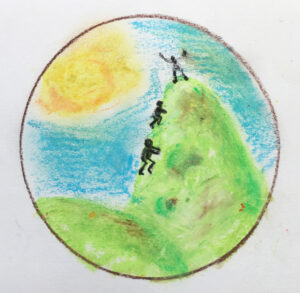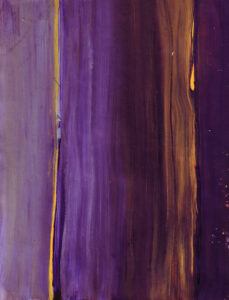In the “Art for Self Discovery” workshops we’ve been running recently, we’ve seem people come for many different reasons. Most are just “regular” folks who are curious about what their art is saying. Some have heard about art therapy and want to learn more about it. Some are artists who are stuck and want to jump start their creativity. Others are art therapists who just want a place to do their own artwork in the company of others.
Art Trauma
Regardless of their reasons, what they all seem to share is that most them are recovering to some degree or another from what we call “Art Trauma” (we include ourselves in this as well). Art trauma results from negative messages we got or negative beliefs we formed about art when we were young. Some people remember having teachers or friends make fun or criticize their artwork or force them “color in the lines.” Other people just have rigid ideas about what “real art” is and feel like you are either born artistically talented and creative or you are not.
Beliefs About Creativity and Art
Even people who identify as artists can be very hung up about what “Art” is. They may be perfectionistic, especially if they’ve gotten compliments for their work and feel like they have to make something just as good the next time. Or maybe they want to do something different and fear that people will only accept this new direction. Or they might have a tyrannical “Inner Critic”, a part of them that has very high expectations or that compares their artwork to others’ and feels inferior. Or they might feel stuck and can’t seem to move through a creative block.
Our Ideas about Art
Artists and “non-artists” alike seem to have very rigid ideas about who is an artist. For example, they think it’s someone who sells their art, someone who shows their work in galleries or who has a website, or who was professionally trained as an artist. Or it might be someone who can draw or paint realistically, someone who’s creative, right-brained, innately talented, etc.
Art with a Capital A
And, of course, we also have ideas about what makes “good” art, what we call “Art with a capital A”. That might be that it captures the likeness of something, it’s original, it’s unique, it shows technical skill, it’s balanced and harmonious, the colors are dramatic, it’s large–even better monumental, it carries a message, it’s part of a consistent body of work, etc.
Wanting to Be More Creative
Others people don’t really care one way or another what “Art” is or whether they qualify as an “artist”–they’ve just been told they need a creative outlet and they don’t know how to go about finding one. Or they want to be more creative, they just don’t have time for it, or they never seem to get around to it, other things always come first, etc.
Why You Should Do Art and Be More Creative
With all of art trauma and hang ups that many of us have about art and being an artist, and the internal and external barriers that we experience around doing art—it’s frivolous, it’s only for people with natural talent, you don’t know how to draw, your artwork looks like something a 5 -year-old made, you can’t make a living doing art, etc.—why bother? The answer is that it opens up parts of the mind and gives other parts a rest.

Art Gives Us a Glimpse of Our Inner World
Art gives us a way to see what we usually only experience internally as thoughts and sensations. In other words, it becomes a tangible object that we can look at outside of ourselves rather than our internalized thoughts and/or feelings. First we get things out. Then we can look at them differently.
Visual Signature
Then, when we step back to look at the unique attributes of our artwork, even with the simplest drawing there is a visual signature. We might not see it at first, but others do. It’s our own distinctive way of drawing lines, using color, making shapes, working with space, etc. As we like to say, even if all you draw is a stick figure, it your stick figure.
Art Is Play
Art is experimental. In the true meaning of play, art gives us an opportunity try things out, to make mistakes, to fit things together, take them apart, and reconfigure them. We want art to be more about experimentation and exploration than getting it right and perfection. (That doesn’t mean that it can be that as well, just not only that).
If You Want To Be More Creative But Don’t Know How
First we would suggest that you think about why you yourself want to do so? Do you want to be more expressive, make more beauty in the world, find a fun way to occupy your time, be more playful, solve a problem, learn a particular art technique, emulate someone who’s art you admire, or enjoy an innate talent you but don’t enjoy because you have hang ups about it? Why do you want to do more art? Unpack a little bit of what art and creativity mean to you.
Warm up to Creativity
Then you want to figure out what facilitates your creativity. For some of our folks, it’s having a structured activity such as the one we usually give at our Art for Self-Discovery workshops–make symbols of what is important to you and impacts your life. For others it’s following a book like the Artist Way by Judith Cameron which has exercises like writing for a fixed period of time about any thoughts you’re having no matter how inane or nonsensical they are. For others it’s just playing around with art materials or doodling.
Before Art Trauma/When Did You Enjoy Making Art?
Try to remember if you’ve ever had moments when you were creative or enjoyed doing art before (even if it was when you were a child). Was it coloring books, or making collages of your favorite singers, movie stars, etc. or making paper mâché masks in school? Was it making a poster with your friends or arranging flowers for a dinner party?
What Else Gets You Creative?
Does music motivate you? Being alone or being with others? Going to a museum, watching a “How To” video, going to an art fair, arranging your workspace, going to an supply or craft store. For some people it might be writing prompts, or journaling, picking up an instrument. What warms you up to get creative?

Make It Safe to Make Mistakes
The other critical factor is to lower the stakes. Find ways to experiment in the area that interests you but without needing to get it right. So instead of needing to paint on a canvas right away, start with just making marks on paper, Start small or large whichever feels the least similar to what you are trying to achieve—maybe not even paper just cardboard or newsprint. In other words, start with things that matter less. You can also use your non-dominant hand. Then you can’t get it right. Or do it upside down. Again, just loosening up the expectations and the tendency to want to make something pretty, appealing, successful, finished, etc.
What Gets You Into Action
The point of all of these exercises is to figure out what gets you in to action, replicate that, lessen the stakes, and experiment more. Click here for a handout on Demystifying Creativity that might also be helpful.
Come to One of Our Art for Self-Discovery Workshops
Coming to one of our Art for Self-Discovery workshops might be a good way to get you into action and help overcome any art trauma you’re struggling with. Here is the link to get the dates for the next one. come see if this will get you started!
Warmly, Rebecca and Gioia
The collage at the beginning of this newsletter of the woman looking downward is by Rebecca’s little sister Julia. It’s entitle “Still I Rise” which seemed fitting for this newsletter.
